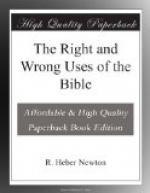Both Paul and James differ very decidedly from the mystic soul who wrote the First Epistle of John; and all three differ again, quite as much, from the philosopher who wrote the Epistle to the Hebrews. How little have either the Apocalypse or Jude in common with Paul! We can no more make a uniform theology out of the New Testament writers than we can out of Calvinism, Arminianism Catholicism, and Unitarianism.
These various theologies can be traced to the elements making up the individualities of the different writers. The idiosyncracies of Paul are clearly marked. He was a man of strong speculative mind, of mystic piety, of lofty enthusiasm for great ideals, a-hungered after righteousness. A Jew and yet a Roman citizen, his education developed the two-fold sympathies of an Israelite of the dispersion. At the feet of the liberal rabbi, Gamaliel, he learned the curious and mystical lore of the rabbins, while drinking in from his Master the spirit of freedom. Thrown from a child in constant contact with the Gentiles of his native city, Tarsus, race prejudices had been sapped unconsciously; while in youth or manhood the wisdom and beauty of the Greek genius had apparently been opened to him.
Paul’s personality, fusing the materials of his education, and out of them building a body of thought around The Christ, explains his theology. He reproduces the conceptions of the rabbis, of the popular Jewish belief, of Gamaliel, of Tarsus, of Athens; transfigured on the heights of thought to which he climbed, in his intense musings over the problem of Jesus of Nazareth, while buried away in Arabia.
The small amount of theology in the practical Epistle of James is quite as plainly Jewish, of the school of the Sages, with a touch of Essenism. The theology of the Epistle to the Hebrews shows throughout the influences of the philosophy of Alexandria. The theology of the introduction to the Gospel according to St. John is just as unquestionably this same Alexandrian philosophy, still further developed.
These variant schools of Christian theology, so plainly revealing the sources of their variations, deny the existence of any one uniform system of thought in the New Testament writers, and pronounce the different systems transient and not final forms.
Whatever the Church may offer us, the New Testament offers us no fixed and final body of thought. In the Bible, Christian theology is still a soft vase, plastic to the touch of each worker upon it. Had Paul’s fine hand played around it even another decade, how different the shape it might have taken.
With the incoming of a more rational, ethical, and spiritual age, we may surely expect a finer fashioning of the forms of thought blocked out in the New Testament, under the first, fresh inspiration of the age of Jesus; into whose larger patterns shall be taken up all the truths revealed through the various sciences of these rich later ages; while all shall still take on the shape of Him who is the image of the invisible God.




